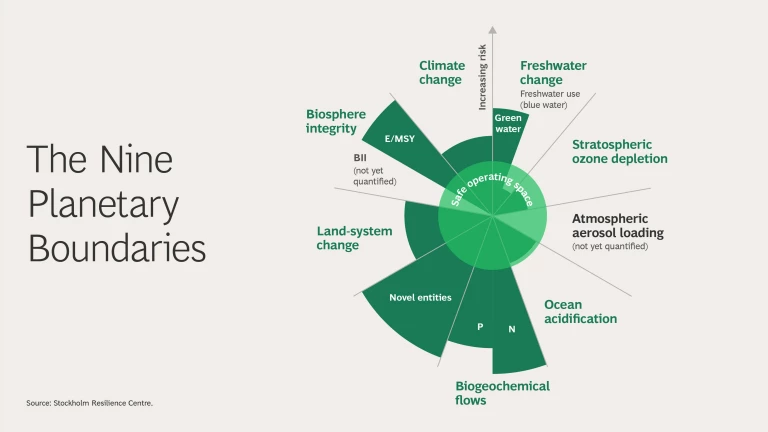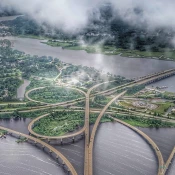What Are Planetary Boundaries?
Planetary boundaries are a scientific framework that define how human activities can operate within the limits, avoid destabilizing the biological and chemical cycles that underpin Earth systems, and decrease the risk of irreversible environmental change.

The nine planetary boundaries represent a set of environmental change processes that regulate the stability and resilience of the Earth systems, including climate change, ocean acidification, biodiversity loss, and others. The concept of planetary boundaries aims to provide a science-based approach to understanding the limits of the Earth's capacity to support human development, while also ensuring that human activities do not exceed these limits and cause irreversible environmental damage.
We are dependent on nature and demanding of its resources, and ecosystems are now declining faster than at any other time in history. Managing and mitigating these nature-related risks and climate risks requires a much wider lens than most organizations have adopted.
The planetary boundary that many are familiar with is climate change, but climate change is just one of nine boundaries. The others are biosphere integrity, land system change, novel entities (such as toxic substances), freshwater change, stratospheric ozone depletion, atmospheric aerosol loading, ocean acidification, and biochemical flows. Between these dimensions, complex feedback loops exist, with an imbalance in one driving further deterioration in others.
Only when all nine planetary boundaries are taken together can companies begin to evaluate their exposure to nature-related risks. Leaders need to think through how business activities may affect each of the planetary boundaries and, as crucially, how each of the boundaries may affect business performance.
Who Created Planetary Boundaries?
In 2009, Johan Rockström, then the director of the Stockholm Resilience Centre, led a group of 28 internationally renowned scientists to identify the processes that regulate the stability and resilience of the Earth system. Then, for each planetary boundary, the scientists proposed quantitative levels within which humanity can continue to develop and thrive for generations to come.
Since then, the concept of planetary boundaries has gained widespread recognition and has been used as a basis for environmental policy and decision-making at the global level.
Which of the Nine Planetary Boundaries Have Already Been Passed? And What Are the Consequences?
All of the nine boundaries defined by the planetary boundaries framework have been crossed, are at risk of being crossed, or have not been properly addressed with the exception of one: Stratospheric ozone depletion.
The consequences of crossing planetary boundaries are complex and interconnected, and can lead to cascading effects that generate abrupt or irreversible environmental changes on a large scale.
Should You Embed Both Climate and Nature into Transition Strategies?
We say that climate and nature are two sides of the same coin because they are fundamentally interconnected and mutually dependent. The Earth's climate and natural systems are intricately linked and influence each other in complex ways.
It’s critical that companies broaden their net-zero carbon emission strategies and ambitions to include nature. There’s no time to waste, especially because many companies are finalizing their carbon plans. Here's why:
- A majority of human-made carbon emissions are captured by the oceans and forests.
- Nature-based solutions, such as planting trees, are 30% of the mitigation solutions that are economically viable by 2030.
- Nature is also a significant source of the possible climate adaptation and resilience approaches, such as utilizing mangroves to protect coastal cities from floods and storms.
If they don’t embed both climate and nature into transition plans now, they will face the painful prospect of needing to revise these plans in several years. This is a challenge but also an opportunity. After all, addressing nature more holistically to avoid environmental change will surely help to achieve carbon goals.
How Do We Help Clients Protect the Planet Across Planetary Boundaries?
In 2022, BCG acquired Quantis —which helps develop and deliver bespoke strategies to align with planetary boundaries—in order to lead the global transformation toward a new planetary economy in which business gives nature a seat at the table.
Together, we help companies create nature-positive strategies, integrate nature-based solutions into their businesses, and build resilience across the nine planetary boundaries by focusing on three initial tasks:
- Assess materiality, establish the baseline, and set targets. To understand what the nature transition means for their companies, leaders should conduct a materiality assessment aimed at identifying the company‘s nature-related impacts and dependencies. Then, these dependencies need to be prioritized and analyzed to identify key metrics and current baselines. After that, management can articulate its aspirations and commitments; consequently, they can and embed those in achievable targets.
- Build action plans to mitigate risks to the planet and the business. These actions can take four forms: avoid and reduce nature impacts and dependencies by making operational improvements; transform and innovate by redesigning existing business models, processes, and products to reduce nature risks and enhance the business performance; restore and regenerate by offsetting the remainder of impacts to deliver nature positivity; and create new green products and business opportunities that rely on nature as a source of competitive advantage.
- Put in place the infrastructure needed to support the nature transition. This infrastructure must include the governance, organization, and people needed to oversee and support the transition; the ecosystems and partnerships needed to provide leverage and expertise; and the required internal capabilities, including risk management, financial valuation, and monitoring tools.
Our Insights on Planetary Boundaries and Environmental Change










